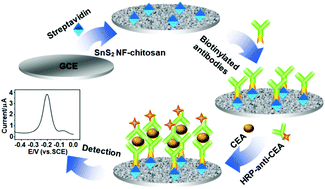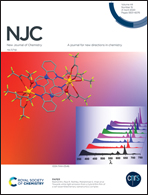A streptavidin-functionalized tin disulfide nanoflake-based ultrasensitive electrochemical immunosensor for the detection of tumor markers†
Abstract
In this research, we reported effective streptavidin-functionalized tin disulfide nanoflakes (SnS2 NFs) to develop an ultrasensitive electrochemical immunosensor for the bioanalysis of tumor markers. The streptavidin-functionalized SnS2 platform and immunosensor were characterized by scanning electron microscopy, electrochemical impedance spectroscopy, static water contact angle measurements and cyclic voltammetry. Biofunctionalized SnS2 NFs displayed a large specific surface area and outstanding hydrophilicity. These characteristics enhanced the loading efficiency and capacity of antibodies on the biosensing platform and ensured the biological activity of the immobilized protein biomolecules. Carcinoembryonic antigen (CEA) was chosen as the model analyte, and a wide linear range of 0.006–3.0 ng mL−1 with a low detection limit of 5 pg mL−1 for CEA was exhibited by the immunosensor. Human serum sample analysis was achieved through the CEA immunosensor with satisfactory results. Streptavidin-functionalized SnS2 NFs offer a potential platform for the expansion of electrochemical immunosensor applications.



 Please wait while we load your content...
Please wait while we load your content...